With the passing of another year comes the passing of a whole decade of modern reefing decade behind us. The pace of things may seem steady to the casual aquarist but when I think back to what reef tanks looked like and how they were run back in 1999, the contrast is quite apparent. I invite you to follow along with me as I take a trip down reefing memory lane and try to recount all of the major changes which have transformed the reef aquarium hobby over the last 120 months. I can’t promise to recount every little detail but I think the veterans reading this will agree that most of the milestones are covered.
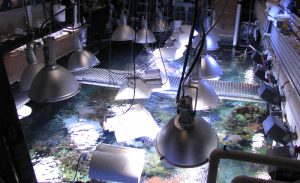
Although many hobbyist tanks are migrating to more efficient double-ended halides, T5 fluorescents and LEDs, for the biggest reefs nothing short of 1000 watt mogul halides will do.
Lighting
Save for the past year, the basic technology of reef aquarium lighting has been fairly stable: fluorescent bulbs and metal halides have been the mainstay lighting source for all coral keepers, even if their forms and power factors evolved a great deal over the past decade. At the beginning of the year 2000, you were as likely to see a tank being lit with a few banks of very high output (VHO) fluorescents or power compacts as you were to see a tank using 175 and 250 watt single ended metal halide with a flat or convex reflector. For a long time most of the tanks using VHO or PC bulbs often used a retro kit to mount these lights into a canopy over the tank. Eventually the thinner PC lamps were the easiest fluorescent form factor to adapt to the aquarium striplights which most aquarists were used to using. When the last decade began Custom Sealife had been building rather heavy duty PC lights made from bent sheet metal but the market for cheaper PC lights really took off when
companies like All-Glass and JBJ began to build more affordable plastic PC striplights. Since PCs were only available up to 3 feet long and VHOs were available up to 6 feet long, many small to medium sized tanks used power compacts and larger tanks tended to use Very High Output fluorescents. For years VHO and PC lighting maintained an equal presence in the hobby but when T5 lamps started being developed for aquarium use mid way through the decade, the battle of fluorescent lighting dominance quickly fell to the thinner and more efficient newcomer. The lower power demands of T5 lamps and their subsequently smaller electronic ballasts made T5s the pervasive fluorescent lighting technology in a short amount of time. Also, a high quality VHO or PC lamp that would have cost about $35-40 in 1999 can now be replaced by two T5 lamps that may cost $19 each but together with two individual reflectors they can illuminate a much broader area. At the present, it is safe to say that normal and
high output T5 fluorescent lamps are the most popular entry-level reef aquarium lighting in the world but T2 fluorescent lamps are looming on the horizon. All of these mass market high intensity fluorescent lighting products have been critical to making reefing more accessible and affordable to a broader audience, helping to grow the reefing hobby and to boost the sales and development of even more powerful reef lights.
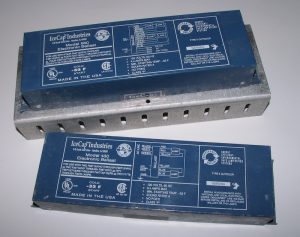
These 660 and 430 IceCap VHO fluorescent lamp ballasts were once the epitome of reef aquarium lighting, yet for being over 15 yrs old they can still drive a VHO or overdrive a T5 as good or better than any ballast.
Ten years ago a metal halide lighting setup was usually more awesome in the amount of power it used and how much space it could take up than in the sheer amount of light and color rendition it could produce. Boxy metal halide fixtures from Coralife and Hamilton with isolated and widely spaced out mogul sockets backdropped against a flat sheet of aluminum were the norm. Sometimes these metal halide coffins would be paired with with some form of supplemental actinic lighting but for too long the power of the appliance was the only metric indicating how much light was actually coming from the fixture. Early in the decade the reefing hobby began to see more shapely reflectors, a wider diversity of lamps with increasingly larger Kelvin ratings as well as the emergence of double ended metal halide lamps. Reefers had long known about the exotic European “HQI” metal halide with it’s curiously small size and contacts at either end. The first HQI light fixtures were very expensive German
made luxury products from AquaMedic and Giesemann that cost twice as much overall as a comparable American mogul base light fixture. Like the T5 lamps, the smaller and more efficient double ended halide lamps proved much easier to manufacture into mass market fixtures and aside from the larger 400 and 100 watt lamps the double ended halide lamp is the most common form of high intensity lighting in use today.
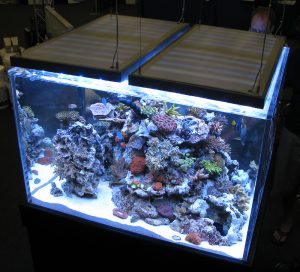
This demonstration aquarium set up by Quality Marine shows the potential of LED lighting when many of them are used in series.
By the middle of the decade Dr. Sanjay Joshi had already performed an evaluation of various metal halide lamp, ballast and reflector combinations that were published in innumerable articles. Joshi’s work showed the average aquarist that the type of lamp, ballast and reflector could all have a huge effect on the real world PAR value that would occur in an average aquarium sized volume. The Kelvin ratings of MH lamps had been tossed around very loosely by bulb manufacturers but Dr. Joshi also showed that different lamps with the same Kelvin rating label could have a vastly different PAR value and measured color rendition index. Thanks to Sanjay’s mountain of metal halide lighting data reef aquarists are now much better educated about ballasts and lamps and we all know that a larger reflector is usually a better reflector for driving light down onto our corals. The past year has been good to aquarium metal halide lighting with a few new tricky ballasts and lamps. We now have available
to us the TwinArc lamp from Reefbrite lighting which has dual inner envelopes that alternate with every switch of the ballast; the TwinArc costs the same as a regular halide lamp but it has envelopes that can be of the same color or in combinations of 10K and 20K. Some new electronic ballasts can adjust the driving current to sustain lamp intensity and life and other ballasts can be dimmed or switched to drive either 250 or 400 watt lamps. Also, this past year has seen the growth of yet another smaller metal halide form factor with the G12 lamps in 70 and 150 watt configurations and an HID spotlight that is 35 watts.

A new LED fixture from Marineland might be designed primarily for illumination but the thin and sleek design is hint of what reefers can expect from future LED aquarium lights. No gutters here!
It seems like LED reef lighting has been a dream on the horizon for the better part of the last ten years. The first breakthrough aquarium LED product, the Marc Weiss moonlight, may have simply been a glorified nightlight but from that humble beginning LEDs have persisted in the aquarium hobby. Few people actually use moonlights on a lunar cycle but the twilight simulation has definitely helped aquarists witness a lot more reef fish spawning. The first full fledged reef light was the PFO Solaris light and ever since the evolution of LED aquarium lights has been phenomenal and the growth of their usage exponential. The past 12 months have been particularly prolific with the emergence of LEDs in a dizzying variety of form factors including actinic striplights from Reefbrite, spotlights from Japan and NanoCustoms and the formation of Ecoxotic, an aquarium lighting company that exclusively designs and produces LED products. LED reef lighting technology is still very immature but the
next two years will be transformative and I predict that we will soon experience a sea-change in how our reef aquariums are lit using LED lights.

Two maxijet powerheads in service on Sanjay’s soft coral reef tank. One uses the propeller modification and the other is using the original stock impeller.
Water Flow
If the 90’s reefing discussion was dominated by how to deliver increasingly more intense light for our corals then reefing in the noughties (00-09) saw some major changes in coral husbandry with much more attention being paid to how water flow could be increased and ameliorated to the benefit of corals and the entire captive reef ecosystem. The initial dogma of water flow in mini-reef aquaria was characterized by “random, chaotic, turbulent” flow. At the beginning of the decade a mini reef tank was likely to be flowed by a battery of internal powerheads which at that time were comparatively weak. With many poorly designed pumps on the market the more pumps you had in your tank the more likely you were to suffer some kind of meltdown from your poorly epoxied water mover. Some larger tanks used the more powerful “top-loading” powerheads which transferred much less heat to the tank and although these Top pumps were fairly dependable, they were loud and required lots of maintenance to
keep in peak working order. That old school water flow was provided by very quick flow alternations which was often glorified and overpriced power strips which did more to wear out our poor powerheads than to provide truly efficient and useful water movement.
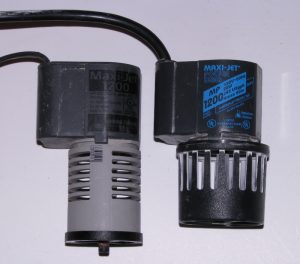
A new maxijet water pump outfitted with one of the first handmade propeller modifications and an older version of the maxijet outfitted with one of the mass-produced molded maxijet mods.
The first big shift in aquarium flow pumps started to develop when DIYers began discussing the possibility of using propellers on the shaft of their impeller style powerheads. Like the propellers of boat motors it was believed that this type of water flow production would be much more efficient and effective. In early 2002 a modification kit for the little giant PE series pumps was released by Jimmy Chan of Reeftec. The modkit included a propeller and mounting bracket which allowed you to modify your PE little giant from Lowes or Home Depot into a veritable powerhouse of water flow. The little giants PE which were modified in this way were called Reeftec pumps and although the whole assembly was very bulky and the propeller was prone to shearing off from the shaft, when they worked the Reeftec pumps were the best water pushers available to reefers. The Reeftec pumps could have remained an important reefing equipment well into the future but at Interzoo 2002 tunze announced the
release of the Stream line of propeller-style water pumps and once again an innovation that had started in the DIY realm was adopted for mainstream products; reef aquarium water flow was never the same again.
Like other first generation technologies the propeller stream pumps from tunze drastically changed the way we push water around but they were expensive and some models had reliability issues. The bulky stream pumps had a very large motor block which was mounted to a magnet which straddled the glass and allowed the wide nozzle of water to be directed in any direction. For at least a couple years tunze’s Stream pumps were alone in the propeller water pump market but thing began to change in 2004-2005. Following on the successes of the home-made Reeftec water pumps, DIY reefers revisited the idea of making a propeller water pump, this time using the more widely available Maxijet water pump. Unlike the unidirectional little Giant PE, the maxijet has a bidirectional impeller that works to pump water no matter which direction it spins. Early maxijet modders had to develop a mechanism for making sure the impeller spins in the right direction but once this was achieved, the hobby began
seeing many small scale, hand made DIY mod kits available for sale. The home made kits were affordable and they did the job of turning the workhorse Maxijet into a nice little prop pump and within a couple years the kits would be available in a mass-produced and molded form which is one of the best selling entry-level prop pumps for reef tanks today.

The original Vortech controller and one of the first 50 handmade beta MP40 water pumps.
Right about the time that the smaller MJ mod began to make waves in smaller tanks, a little company called EcoTech Marine was working on a magnetically coupled propeller pump that could push a lot of water but at the same time be very discreet within the aquarium. At the Washington MACNA in 2005 EcoTech showed off the first prototypes of it’s MP40 vortech water pump. The vortech pump was amazing for it’s size, power and unique coupling mechanism but when they told MACNA attendees that they would be forming a company that would specialize in selling only this pump for the skyscraping price of 0 a piece we all ‘knew’ that the vortech pump would be short-lived. With this thought in mind I made a significant investment in two of the first 50 hand made Vortechs that EcoTech offered for sale and I am proud to say that these two Beta pumps are still running to this day. Over time EcoTech made an economy version of the vortech, the MP20 and it also added a controller to run the pumps
with multiple programs, adjustable settings and wireless sync capabilities. Despite it’s high end price tag the near-ubiquity of the vortech water pump is a testament to how much reefers have embraced propeller flow technology. Today propeller water pumps are the dominant form of water motion in most reef aquariums.
As propeller water pumps all but displaced the old style impeller water pumps as the most popular way to flow a reef tank, other pump manufacturers like Rio, Aquarium Systems Europe and Coralife have all fallen in line with propeller water pumps of their own. More recently, tunze has completely upgraded their Turbelle Stream pumps to the Stream 2 line and Italian manufacturer Hydor released an economy propeller style water pump called the Hydor Korallia. The affordable Korallias ship with a suction-cup assisted magnetic mount that can be oriented in every direction and along with modified Maxijets the Korallias make up the bulk of the water flow pumps used in small and medium sized reef set ups.
Before the large Stream and vortech pumps came along, the owners and designers of large reef tanks were still scratching their heads trying to figure out a way to install powerful external water pumps to large reef tanks in a way that would produce the most efficient water flow. The community collectively realized that plumbing a large water pump straight to and from the display tank in a “closed-loop” fashion could yield a lot of water movement. The closed-loop (as it was eventually called) was one of the only ways to add a high amount of water flow to a large reef tank without adding a lot of equipment to the display aquarium and sullying the view of the reefing scene. Early closed loop protocols called for flow-rated pumps that would simply crank out a ton of water volume through the standard Loc-Line fittings in a very static way. Once the closed-loop had become well established and widely accepted, the door was opened for companies like OceansMotions and 3iQ Ventures to
develop their respective flow deflecting devices which alternated the direction in which the water current flowed. The electric OceansMotions was a popular device for medium and large sized aquariums and the SCWD (Switching Current Water Device) was widely sold for returns and closed loops alike where this device was able to do it’s trick powered only by the movement of water passing through it. Both the OceansMotions and the SCWD had some issues in their early models but better engineering and development has improved both of these devices which are still used to this day. Perhaps a larger contributor to the effectiveness of closed loops is the advent of eductors and penductors. An eductor is a attachment which operates on the end of an outlet of water flow and it uses a nozzle spraying into a trumpet shape to convert the energy from high pressure water into lower pressure, higher volume water flow. Eductors were originally designed for large scale mixing applications but the design
was eventually shortened into a smaller device we call penductors. A modern closed loop system will now usually employ a pressure rated pump which may deliver less water volume to the tank but when coupled with flow switching devices and eductors they can produce a very reliable water motion while still keeping most of the components outside of the aquarium.

This aquarium employs several closed loops that include flow oscillators and penductors on the outlets.
All of these changes in water movement technology for the reef aquarium undescore the shift towards the implementation of “Mass Water Movement” which is best demonstrated by the use of Gyre Flow. New School reefing dogma has moved away from a perception that random chaotic flow is desired towards an understanding that faster, more even movement of the entire aquarium volume is better for the reef, better for the corals and much easier to produce. Whereas a reef tank of the last century was usually more of a firing squad of underpowered water jets which may have been pointed in random directions and turned on and off without any rhyme or reason, in the 21st century the design of reefing flow is much more thought out: powerheads, propeller pumps and closed loops work together to move as much water movement as possible, often in a gyre flow pattern, while using less energy and taking up much less space within the aquarium.
There are many other examples of marginal products and techniques in reef and aquarium flow and lighting but the article above does a fair job of putting together an accurate synopsis of how these two reefing realms have evolved in the past decade. Join me next time when I review how protein skimmers, additives and overall reefing techniques have changed since 1999.






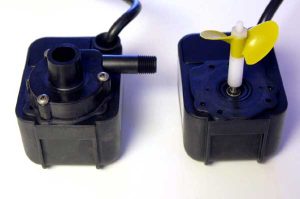
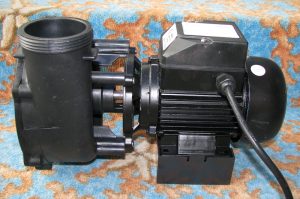

0 Comments